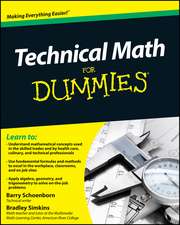Transforming Domain into Boundary Integrals in BEM: A Generalized Approach: Lecture Notes in Engineering, cartea 35
Autor Weifeng Tangen Limba Engleză Paperback – 22 iun 1988
Din seria Lecture Notes in Engineering
- 15%
 Preț: 640.37 lei
Preț: 640.37 lei - 15%
 Preț: 643.34 lei
Preț: 643.34 lei - 15%
 Preț: 632.70 lei
Preț: 632.70 lei - 18%
 Preț: 1049.30 lei
Preț: 1049.30 lei - 15%
 Preț: 637.59 lei
Preț: 637.59 lei - 15%
 Preț: 638.89 lei
Preț: 638.89 lei - 15%
 Preț: 637.93 lei
Preț: 637.93 lei - 15%
 Preț: 635.96 lei
Preț: 635.96 lei - 15%
 Preț: 637.78 lei
Preț: 637.78 lei - 18%
 Preț: 957.13 lei
Preț: 957.13 lei -
 Preț: 397.01 lei
Preț: 397.01 lei - 15%
 Preț: 653.79 lei
Preț: 653.79 lei - 15%
 Preț: 638.57 lei
Preț: 638.57 lei - 15%
 Preț: 634.82 lei
Preț: 634.82 lei - 15%
 Preț: 644.18 lei
Preț: 644.18 lei - 15%
 Preț: 635.15 lei
Preț: 635.15 lei - 15%
 Preț: 637.93 lei
Preț: 637.93 lei - 15%
 Preț: 633.19 lei
Preț: 633.19 lei - 15%
 Preț: 653.79 lei
Preț: 653.79 lei - 15%
 Preț: 636.45 lei
Preț: 636.45 lei - 15%
 Preț: 651.02 lei
Preț: 651.02 lei - 20%
 Preț: 645.31 lei
Preț: 645.31 lei - 15%
 Preț: 639.08 lei
Preț: 639.08 lei - 15%
 Preț: 633.19 lei
Preț: 633.19 lei - 15%
 Preț: 655.13 lei
Preț: 655.13 lei - 15%
 Preț: 652.49 lei
Preț: 652.49 lei - 15%
 Preț: 652.81 lei
Preț: 652.81 lei - 15%
 Preț: 643.48 lei
Preț: 643.48 lei - 20%
 Preț: 640.51 lei
Preț: 640.51 lei - 15%
 Preț: 675.58 lei
Preț: 675.58 lei - 15%
 Preț: 639.59 lei
Preț: 639.59 lei - 15%
 Preț: 642.18 lei
Preț: 642.18 lei - 15%
 Preț: 638.43 lei
Preț: 638.43 lei -
 Preț: 434.12 lei
Preț: 434.12 lei - 15%
 Preț: 642.68 lei
Preț: 642.68 lei - 15%
 Preț: 647.27 lei
Preț: 647.27 lei - 15%
 Preț: 655.92 lei
Preț: 655.92 lei - 15%
 Preț: 665.73 lei
Preț: 665.73 lei -
 Preț: 411.64 lei
Preț: 411.64 lei -
 Preț: 406.80 lei
Preț: 406.80 lei - 15%
 Preț: 634.68 lei
Preț: 634.68 lei - 15%
 Preț: 650.86 lei
Preț: 650.86 lei - 18%
 Preț: 974.49 lei
Preț: 974.49 lei - 15%
 Preț: 642.68 lei
Preț: 642.68 lei - 15%
 Preț: 635.31 lei
Preț: 635.31 lei - 15%
 Preț: 640.37 lei
Preț: 640.37 lei - 15%
 Preț: 636.45 lei
Preț: 636.45 lei - 20%
 Preț: 659.63 lei
Preț: 659.63 lei - 15%
 Preț: 651.51 lei
Preț: 651.51 lei
Preț: 638.24 lei
Preț vechi: 750.88 lei
-15% Nou
Puncte Express: 957
Preț estimativ în valută:
122.12€ • 127.85$ • 101.05£
122.12€ • 127.85$ • 101.05£
Carte tipărită la comandă
Livrare economică 05-19 aprilie
Preluare comenzi: 021 569.72.76
Specificații
ISBN-13: 9783540192176
ISBN-10: 3540192174
Pagini: 220
Ilustrații: V, 209 p.
Dimensiuni: 170 x 244 x 12 mm
Greutate: 0.36 kg
Ediția:Softcover reprint of the original 1st ed. 1988
Editura: Springer Berlin, Heidelberg
Colecția Springer
Seria Lecture Notes in Engineering
Locul publicării:Berlin, Heidelberg, Germany
ISBN-10: 3540192174
Pagini: 220
Ilustrații: V, 209 p.
Dimensiuni: 170 x 244 x 12 mm
Greutate: 0.36 kg
Ediția:Softcover reprint of the original 1st ed. 1988
Editura: Springer Berlin, Heidelberg
Colecția Springer
Seria Lecture Notes in Engineering
Locul publicării:Berlin, Heidelberg, Germany
Public țintă
ResearchCuprins
1 General Introduction.- 1-1 Numerical Methods.- 1-2 Domain Methods.- 1-3 Boundary Element Method.- 1-4 The Main Procedures and Features of BEM.- 1-5 The Subject of this Work.- 1-6 Contents of the Present Work.- 1-7 The Cartesian Tensor Notation.- 2 Potential Problems.- 2-1 Introduction.- 2-2 The Boundary Integral Formulation for Potential Problems.- 2-3 The Boundary Element Method for Potential Problems.- 2-4 Motivation and General Ideas.- 2-5 Fourier Analysis.- 2-6 Basic Formulations for Transforming the Domain Integrals into the Boundary for 2-D Problems.- 2-7 Numerical Approaches.- 2-8 Numerical Accuracy of the Transformation Formula.- 2-9 Some Further Discussions.- 2-10 Examples.- 2-11 The Transformation Formula for 3-D Poisson’s Equation.- 2-12 Applications in Time-dependent Problems.- 2-13 Application in Non-linear Problems.- 3 Linear Elastostatics.- 3-1 Introduction.- 3-2 Basic Relationships of Elasticity.- 3-3 Fundamental Solution for Elastostatics.- 3-4 Somigliana Identity.- 3-5 The Boundary Integral Equations of Elastostatics.- 3-6 The Boundary Element Method in Elasticity.- 3-7 Basic Formulations for Transforming 2-D Elasticity Domain Integrals to the Boundary.- 3-8 Numerical Implementation.- 3-9 Results of Numerical Experiments.- 4 Applications in Elasticity and Elasto-Plasticity.- 4-1 Introduction.- 4-2 An Example of Gravitational Loading.- 4-3 An Example with a More General Type of Distributed Loading.- 4-4 Relationship between Plastic Stresses and Plastic Strains.- 4-5 The Governing Equations for Elasto-Plasticity.- 4-6 Numerical Analysis using Finite Fourier Series.- 4-7 Application to Elasto-plastic Problems.- 5 Programming.- 5-1 Potential Problems.- 5-2 Elasticity Problems.- 5-3 Elasto-Plasticity Problems.- 6 General Discussion and Conclusions.-References.









